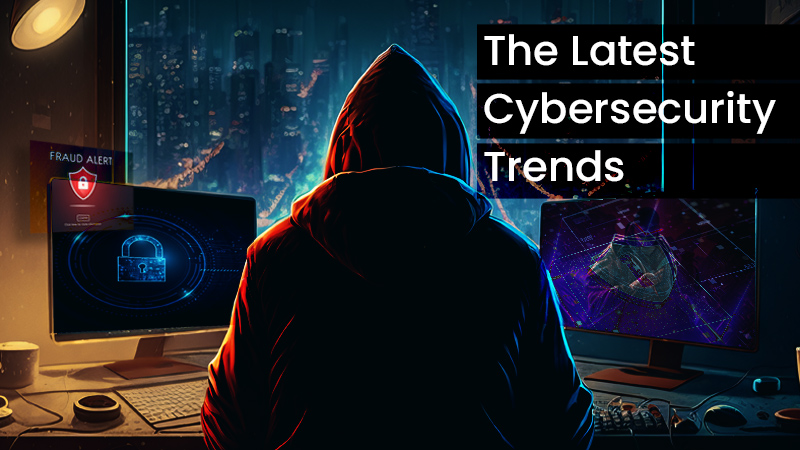Top Cybersecurity Trends for 2023

Cybersecurity is an ever-evolving field that is constantly adapting to new threats and challenges. As technology continues to advance, so do the methods and tactics used by cybercriminals. It is important for organizations and individuals to stay informed on the latest cybersecurity trends and developments in order to stay protected against online threats. In this blog, we will examine some of the latest cybersecurity trends and how they are shaping the future of the field.
Artificial Intelligence (AI) and Machine Learning (ML)
One of the biggest trends in cybersecurity is the increasing use of AI and ML technologies. AI and ML algorithms can process vast amounts of data in real-time, allowing them to identify and respond to cyber threats much faster than traditional security systems. For example, AI-powered intrusion detection systems can quickly identify and respond to suspicious activity, while ML-based threat detection systems can automatically identify new and evolving threats.
Moreover, AI and ML can be used to automate many of the manual tasks that cybersecurity professionals typically perform, such as malware analysis and threat intelligence gathering. This can free up time for security teams to focus on more complex and strategic initiatives, as well as provide a more comprehensive and effective approach to security.
Cloud Security
Cloud computing has become increasingly popular in recent years, with more and more organizations relying on cloud-based systems and services to store, process and access data. However, this increased dependence on the cloud has also created new security challenges. As a result, cloud security has become a top priority for organizations of all sizes.
Cloud security solutions are designed to protect data and systems from cyber threats, and many cloud providers now offer security services and features as part of their offerings. For example, some cloud providers offer encryption, access control, and monitoring capabilities to help secure data in the cloud. In addition, companies can also find a number of third-party security solutions specifically designed for cloud environments.
Internet of Things (IoT) Security
The Internet of Things (IoT) refers to the growing number of connected devices that are becoming increasingly common in our daily lives, such as smart home devices, wearable technology, and connected cars. While these devices offer many benefits, they also pose a number of security risks.
IoT security is becoming a major concern as more and more devices become connected, and attackers look for new ways to exploit these devices. For example, a hacker could potentially take control of a smart home device and use it to gain access to other systems and devices on a network. To address these risks, organizations are turning to IoT security solutions that can help protect these devices from cyber threats.
Quantum Computing
Quantum computing is a new and rapidly developing field that is poised to have a significant impact on the world of cybersecurity. While traditional computers use bits to represent information, quantum computers use quantum bits, or qubits, which can be in multiple states at the same time. This allows quantum computers to perform certain computations much faster than traditional computers.
While quantum computers have the potential to greatly enhance many fields, they also present a major challenge for cybersecurity. Currently, many of the encryption algorithms used to secure sensitive data and systems rely on the fact that it is computationally infeasible to factor large prime numbers. However, quantum computers have the potential to solve this problem much faster than traditional computers, potentially making current encryption algorithms vulnerable.
Human Factors
Despite advances in technology, the weakest link in any security system is often the human element. Cybercriminals can easily manipulate people into revealing sensitive information, downloading malicious software, or falling for phishing scams. As a result, organizations are increasingly focusing on addressing the human factors that contribute to cybersecurity incidents. This involves not only providing employees with security awareness training, but also implementing technical controls to mitigate the risks posed by human error.
For example, organizations may implement multi-factor authentication (MFA) to reduce the risk of account compromise due to weak passwords. Additionally, they may implement email filtering solutions to block phishing attempts and malicious attachments.
Privacy and Data Protection
Privacy and data protection have become major concerns in the field of cybersecurity due to the increasing amount of personal data being collected and stored by organizations. As a result, organizations are taking steps to ensure that they are complying with privacy regulations, such as the European Union’s General Data Protection Regulation (GDPR) and the California Consumer Privacy Act (CCPA).
In addition to complying with privacy regulations, organizations are also looking for ways to secure personal data and prevent data breaches. This includes implementing encryption, access controls, and other technical controls to protect sensitive information.
Conclusion
The field of cybersecurity is constantly evolving, and organizations must stay informed and proactive in order to stay protected against online threats. The cybersecurity trends discussed in this blog, such as the use of AI and ML, cloud security, IoT security, quantum computing, and the human factor, will continue to shape the future of cybersecurity and determine the priorities for organizations and individuals alike. By staying informed and taking proactive steps to address these trends, organizations can better protect themselves and their customers from cyber threats.
